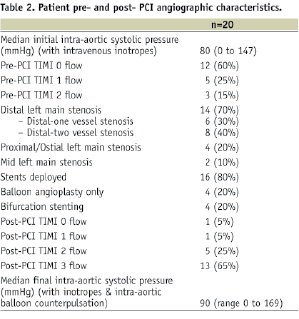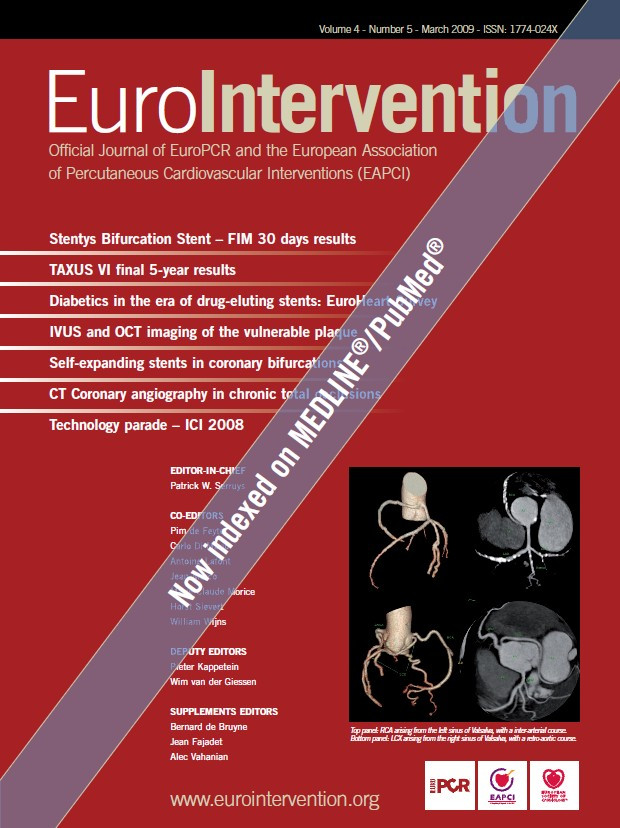Abstract
Aims: There is no consensus on the optimal management of acute myocardial infarction due to acute left main coronary occlusion (LMCO). We evaluated the feasibility of primary percutaneous coronary intervention (PCI) for acute LMCO in an institution without on-site cardiothoracic surgical (CTS) support.
Methods and results: We retrospectively identified 20 patients, median age 67 years (range 38 to 81). Sixteen patients presented with cardiogenic shock. All patients required intra-aortic balloon pump counterpulsation and inotropic support. Sixteen patients underwent stenting and four had balloon angioplasty only. Thrombolysis In Myocardial Infarction 3 flow was restored in 13 patients. Post-PCI, six patients were transferred to a tertiary institution for further care: three underwent extracorporeal membrane oxygenation (ECMO), one underwent both ECMO and coronary artery bypass grafting (CABG), one died before ECMO initiation and one stabilised without further intervention. Thirteen patients died in-hospital. There was one subsequent death out of the seven hospital survivors, with median follow-up 390 days (range 60 to 660 days). There was a trend towards survival with a shorter door-to-balloon time (p=0.07).
Conclusions: Primary PCI may be a feasible initial revascularisation strategy for acute LMCO in centres without on-site CTS support.
Introduction
Left main stenosis has been discovered in the acute settings where interventional strategies have changed in favour of urgent coronary angiography in cases of acute coronary syndromes.1,2 Patients with acute left main coronary occlusion (LMCO) often present with cardiogenic shock. There is no consensus on the optimal management of acute myocardial infarction (AMI) due to acute LMCO.3-5
We evaluated the feasibility of primary percutaneous coronary intervention (PCI) for acute LMCO within our institution which lacks on-site cardiothoracic surgical support. To our knowledge, this has not been previously described.
Methods
This was a single centre patient registry. From 1 January 2002 to 16 October 2007, 540 patients underwent primary PCI. From these records, we identified 20 consecutive patients who had primary PCI for acute LMCO. The inclusion criteria were a history of chest pain >30 minutes and total or subtotal occlusion of the left main stem on coronary angiography with Thrombolysis in Myocardial Infarction (TIMI) 2 flow or less. A retrospective review of all available in-patient and out-patient clinical records and angiographic data was performed. All angiograms were reviewed by an independent investigator blinded to all baseline data. Angiographic success was defined as restoration of TIMI 3 coronary blood flow.
Continuous data was expressed as median with range of values and categorical data as percentages. The Mann-Whitney test was used for continuous variables. The Fisher’s exact test was used for categorical variables. A p value <0.05 was considered statistically significant. A univariate analysis was performed to identify independent variables associated with in-hospital mortality.
Results
The clinical characteristics of our study population are summarised in Table 1.

Sixteen patients (80%) were in cardiogenic shock on presentation, with one requiring cardiopulmonary resuscitation. The initial non-invasive median systolic blood pressure at the emergency department was 78 mmHg (range 0 to 170). On electrocardiography, 55% of patients had ST-segment elevation in the anterior or antero-lateral leads and the rest had widespread ST-segment depressions with ST-segment elevation in lead aVR. All patients required intravenous inotropes and 55% needed mechanical ventilation. The emergency department physicians’ aim was to achieve haemodynamic stability for rapid transfer of patients to the catheterisation laboratory. The median door-to-balloon time was 64 minutes (range 37 to 630), delays in some cases being due to time spent on resuscitation and discussion with distraught relatives.
The patients’ pre and post-PCI angiographic characteristics are summarised in Table 2.

Intra-procedurally, the median initial intra-aortic systolic blood pressure was 80 mmHg (range 0 to 147), with four patients (20%) in pulse-less electrical activity or asystole before intervention. All patients received loading doses of oral aspirin 300mg, oral clopidogrel 600mg, weight-adjusted intravenous heparin and intra-aortic balloon counterpulsation. Sixty percent of patients had TIMI 0 coronary flow pre-PCI and 70% had distal left main coronary artery disease. Right coronary anatomy was evaluated in only 14 (70%) patients, of which six (43%) had grade 2 or better right-to-left collateral blood flow. Four (20%) patients had balloon angioplasty only. Four (20%) patients had bifurcation stenting: three cases of V stenting and one case of Culotte stenting. Post-PCI, TIMI 3 flow was restored in 65% of patients and the final median intra-aortic systolic blood pressure was 90 mmHg (range 0 to 169).
Six patients (30%) required transfer to a tertiary institution after PCI: three patients underwent extracorporeal membrane oxygenation (ECMO), one underwent both ECMO and coronary artery bypass grafting (CABG), one died before ECMO initiation and one stabilised without need for further intervention.
There were 13 in-hospital deaths (65%) from pump failure, including three on-table deaths. Of the seven hospital survivors, three were those who were transferred to a tertiary institution post-PCI. All seven patients were followed up for a median of 390 days (range 60 to 660 days). A re-look coronary angiography was performed in two patients who then went on to CABG. Two patients declined re-look coronary angiography but remained symptom-free, one patient died at two months from heart failure and one remained on left ventricular assist device support for a month before undergoing a successful cardiac transplantation.
We did not identify any variable that was predictive of in-hospital mortality. However, hospital survivors tend to have a shorter door-to-balloon time (p=0.07).
Discussion
Published studies indicate that up to 92% of patients with acute LMCO present with cardiogenic shock and in-hospital mortality rates range from 33% to 58%.5-9 In comparison, our study population had the lowest initial median systolic blood pressure of 78 mmHg (range 0 to 170) at presentation, with 80% of patients in cardiogenic shock and 60% having TIMI 0 coronary flow pre-PCI. In our institution, coronary angiography and PCI were performed in patients even during on-going cardiopulmonary resuscitation. These factors may explain our higher in-hospital mortality rate of 65%.
Data from the ULTIMA registry revealed a 12 month survival rate of 43% for all patients.5 Other studies have shown mortality rates among hospital survivors ranging from 8% to 17% and our study indicated a comparable 14% mortality rate.6,7,9
Published data reported that suboptimal postprocedural TIMI flow, cardiogenic shock at presentation, absent or poor collateral angiographic circulation were independent predictors of mortality.6-8 Our lack of predictive variables may be due to our small sample size.
Our institution lacks on-site cardiothoracic surgical support. Emergency CABG would require transferring patients to a tertiary institution and may take longer than the haemodynamic circumstances of the patient allows. Emergency catheter interventions can potentially bring about rapid and complete reperfusion. This is especially important given our finding that there is a trend towards survival among patients with a shorter door-to-balloon time.
The main limitation of our study is the small sample size. However, acute LMCO is a rare occurrence with an incidence of 0.37% to 2.96% in patients with AMI undergoing emergent cardiac catheterisation.4-9 Most publications on this medical condition concern small subgroups from larger cohorts of patients undergoing PCI.
Conclusion
Most patients with acute LMCO present with cardiogenic shock with high mortality rate. The primary focus should be to achieve haemodynamic stability and rapid reperfusion, via catheter interventions if necessary, in institutions without on-site cardiothoracic surgical support.

